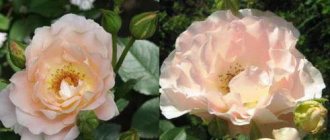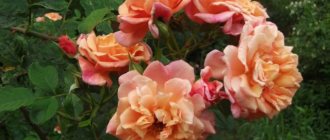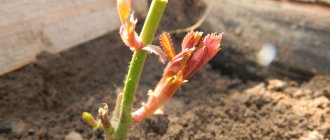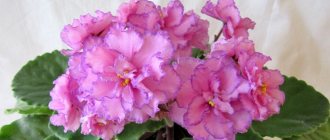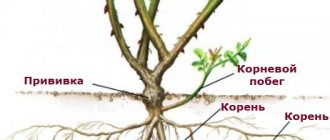Rose floribunda Rumba (Rumba) is a spectacular variety of crop, ideal for gardeners who want to create a unique landscape design in their garden. The variety is re-flowering and decorates the flowerbed in an original way with orange-yellow buds that change color as they grow. Suitable for growing in warm climates.
A distinctive feature of the Rumba rose is its double color
Description and characteristics of floribunda rose variety Rumba
Rose Rumba is a climbing, repeat-blooming and very beautiful variety of the crop, which differs from many other varieties in its compact size. Its bushes do not grow more than 180 cm in length, and do not exceed 120 cm in diameter. The lashes are well leafy. The leaf blades have a typical appearance for the crop, slightly elongated, wide at the base, and pointed towards the end. Their color is dark, emerald, with a characteristic shine. The shoots of the plant do not have thorns.
Rumba rose flowers form quite large, up to 7 cm in diameter, cup-shaped, densely double. When inflorescences bloom, they resemble brushes, each of which consists of three to five buds of unusual color. At the initial stage they are yellow in color, then the outside becomes scarlet, then dark crimson, but in the center the flower remains yellow. The variety is characterized by a delicate, unobtrusive aroma and flowering that occurs in waves.
Rose Rumba has average sensitivity to rain; blooming flowers are damaged by precipitation, but not all. The frost resistance of the crop is low, down to -20-22 °C. It is not recommended to breed it in harsh conditions. In the Urals or Siberia, the Rumba rose freezes even with careful shelter. In the Volga region, Central regions and the middle zone it grows only with careful care. Some gardeners plant it in large flowerpots and put it on a heated terrace for the winter.
The plant is drought tolerant and is not afraid of direct sunlight. There are no burns on its foliage. As for immunity, the variety has an average one. Rumba is prone to diseases common among roses and needs constant prevention.
The biological cycle of this species is long-term, the crop grows slowly, and single buds appear on it only in the third year after planting. The end point of growth occurs in the fifth year of the growing season. Rumba begins to bloom in June, the second wave occurs at the end of July, August, in September the buds bloom when grown in the subtropics.
Rose blossom
The type of flowering in the Rumba variety is wavy. It is abundant and long lasting. The flowers are shaped like small rosettes.
Rose Jazz - characteristics of the varietal shrub
A distinctive characteristic of this shrub is the combination of a flowering activation period with a dormant period. During one season, three waves can change.
For your information! Repeated flowering is always as abundant as the first. It goes on continuously all the time.
After the buds open, the flowers are yellow. Over time, the edges of the petals become bright pink or crimson. The yellowness fades completely over time. The peculiarity of the plant is that the petals of the flowers dry out, but do not fall off the branches. They need to be removed yourself, as this not only spoils the appearance of the shrub, but also reduces the intensity of flowering.
Arches of roses
What to do if it doesn't bloom
If the seedling is only one year old, it may not bloom. This will not be considered a pathology. Most often, climbing roses begin to bloom only in the second year.
Other reasons why there is no flowering are as follows:
- An inappropriate landing site has been selected. The area receives little sunlight or there is a draft;
- Too much pruning was done in the spring;
- lack of the required amount of fertilizers. A weakened bush will not be able to gain strength to bloom.
Important! Weeds interfere with flowering because they take away all the nutrients from the roots of the bush.
Advantages and disadvantages of the variety
Despite the abundance of positive characteristics, the Rumba rose has a number of negative features.
The variety is unable to grow in cold regions
Advantages:
- unusual color of buds;
- pronounced aroma;
- correct shape of flowers;
- absence of thorns;
- resistance to burnout;
- re-blooming;
- universal use.
Flaws:
- sensitivity to rainy weather;
- susceptibility to disease;
- demands on watering;
- intolerance to low temperatures.
What else should you pay attention to?
Mikhail Vostroknutov, designer
Parking space: if you don’t immediately leave room for 2-4 cars, you and your guests will face difficulties and inconveniences in the future. Space for snow: think in advance where you will throw the snow from the paths and parking space in the winter so that you don’t have to remove it with a wheelbarrow or throw it over the fence. Plantings along the roof slope: planting trees and creating paths is done in the summer. But if the plantings and paths are under the slope of the roof of the house, in winter all this will be broken by the falling snow.
The windows of the house are opposite: if you like to show yourself and look at others, you can place the windows opposite the neighbors. In all other cases, a blank wall facing the neighbor's house will be a more correct solution. Paths: when arranging paths on the site, you cannot rush at all! Use the old rule: just wait for people to make their own paths where they find it most comfortable to walk. Only after this can paths be laid on top of the trampled paths.
Reproduction methods
Since the Rumba rose was obtained by crossing several varieties of flowers, it cannot be obtained from seeds. Reproduction is carried out only by cuttings and layering.
The first method is more effective; it allows the young plant to take root well and take root. To carry out the procedure, before the rose budding or at the end of the first wave of flowering, cut off the vine of last year's shoot, divide it into parts of 12 cm, so that each has 2-3 leaves, make an even cut at the top, at an angle at the bottom. Each cutting is treated with an antifungal drug, placed in the ground 5 cm deep, and a greenhouse is built over the planting material.
Important! During the process of rooting Rumba cuttings, they should be provided with proper care: moisture, air circulation.
For the winter, young rose shoots are well covered. With the arrival of warmer weather, they are transplanted to a permanent place.
Flowering of a crop grown from cuttings can be observed after two years
Reproduction of the Rumba rose by layering does not give such good results, since even with a slight drop in temperature or a slight lack of moisture, the plant dies. This method is usually used by gardeners living in areas with warm climates without sudden weather changes.
Exchange of experiences of gardeners from different regions on growing the climbing rose “Rumba”
- Kristina Vladimirovna, (Krasnoyarsk, second zone).
The rose appeared in my garden by accident, due to a mismatch. It was not possible to drop off immediately after the purchase. She stood in the pot for some time and actively grew shoots. After planting, she became ill and had to be trimmed a little. But the very first one bloomed, although it stopped growing in height. The first flowers were small and not very double; when they opened, they showed their middle. Over time, the situation changed, the buds gained density and stopped looking sloppy. I noticed that the flowers can withstand heat and rain.
- Elena Karlovna (Leningrad region, fourth zone).
In the first year, after the rose was planted, I cut off all the buds, as stated in the instructions for the variety. Over the summer, the branches grew more than a meter. Laying them down for shelter for the winter was not difficult. The rose overwintered well. Next year there were 3–5 flowers on each stem. The color changed as stated in the description, first the lower petals on the yellow buds turned red, then the rose changed color completely. This is the most beautiful variety in my garden.
- Maria Ivanovna (Krasnodar region, zone 6).
Something went wrong with my rose from the very beginning. Instead of beautiful double flowers, simple pale buds bloomed. At first I thought there was a mistake. The packaging featured a bright yellow and red rose. Having contacted summer residents on the forum, I found out that they were the only ones with such a problem. Roses purchased at different retail outlets turned out to have the same shortcomings. The manufacturer probably made an error. It is impossible to foresee this, as well as to correct it. Therefore, I had to say goodbye to the rose. I removed it from the garden.
Planting and caring for floribunda rose Rumba
Growing the Rumba grandiflora rose is not a difficult process only if it grows in favorable conditions. When there is instability in the temperature regime, the process of caring for the crop becomes more complicated.
Comment! Rose Rumba is quite demanding when it comes to watering and fertilizing, and is capricious to some external factors.
Conditions and terms of landing
Before planting, you should select a site. It should be well lit and protected from wind and draft. If this rule is not followed, the Rumba rose bush will often get sick, and its flowers will become smaller, fade and fall off immediately after blooming.
The soil for the crop should allow moisture and air to pass through well and be loose. It is better if it is loam or sandstone.
Rumba is usually planted in the spring, in a place prepared in advance. Autumn planting is also possible, but provided that cold weather does not set in for at least another month.
Attention! In September, the plant is planted in a hole prepared in the spring.
How to plant correctly
At least four months before planting a rose of the Rumba variety, the area under it is dug up, at least 5 kg of compost, 30 g of potassium salt and superphosphate are added to the soil, and lime is added. Before planting a seedling, dig a hole 20 cm deeper than its roots. Next, a layer of drainage and fertile soil is poured into it, a mound is made on which the root system of the plant is placed. Pour some soil into the hole, water it to the brim, fill it completely with soil and moisten it again. You can place mulch on top of the soil.
Important! The root neck of the Rumba rose is deepened by 5 cm.
Since the plant needs support, after planting the seedling, a trellis up to 150 cm in height or another structure is inserted near it, on which the pink lashes will be attached during the growth process.
Comment! After just three days, it is recommended to treat the roses against diseases.
Aftercare
In order for the Rumba rose to feel good in the flowerbed, bloom profusely and develop, it needs to be properly cared for.
The main thing the plant needs is abundant moisture without stagnation of moisture. The top layer of soil should always be damp. After watering, the soil must be loosened and weeds must be removed at the same time. It is allowed to mulch the tree trunk circles of the plant.
During the Rumba planting season, there is no need to fertilize it, but in subsequent years, fertilizing is required. The drugs are applied three times a year:
- in early spring - potassium and nitrogen;
- in summer - phosphates;
- at the time of preparation for winter - phosphorus-potassium compounds and minerals.
In spring and autumn, the Rumba rose variety needs pruning and shaping of the bush. In April, frozen, damaged shoots and branches growing inward are removed. At the end of September, weak and non-lignified parts of the plant are cut off.
Comment! At the moment of flowering of the crop, all wilted buds are removed from it.
With the beginning of leaf fall, Rumba floribunda bushes are prepared for wintering. Each one is watered, the water consumption should be two buckets per plant, humus is added (layer 20 cm), fertilizers, and hilling is carried out. In October, the rose lashes are removed from the support, bent to the ground and pinned. A layer of fallen leaves, straw, sawdust is poured on top of the bush, and covered with agrofibre and spruce branches.
In winter, it is advisable to cover the Rumba rose bushes with snow.
Growing a flower
Rose Night Owl - description of climbing climbing
Rumba grows well in illuminated areas with light partial shade during the summer heat, without drafts and constant winds. The soil should be light, neutral or slightly acidic, well fertilized and permeable to moisture. The ideal option is sandstone. The soil is prepared in the fall. To reduce acidity, slaked lime is added to it before digging. For fertility - rotted manure, compost. The hole for spring planting is dug in the fall. Its depth and width must be at least 35 cm.
Attention! Shadow negatively affects the development of the bush. It branches poorly and produces small, inconspicuous inflorescences. In drafts, the rose often gets sick.
Selection and preparation of seedlings
Rumba reproduces with the help of seedlings that have 3-4 shoots. They must be healthy, free from rot and mold, and the root system must be branched, with developed lateral roots. Before planting, the root of the seedling is dipped in a clay mash for 30 minutes to stimulate growth.
The ideal time for planting Rumba is late April-early May or autumn - a month before the onset of frost, so that the plant gets stronger and prepares for the cold.
The process itself consists of the following steps:
- The hole is equipped with drainage made of gravel, small stones, and brick fragments.
- Pour in half a bucket of water, then add a layer of soil mixed with 1 kg of humus and 1 tablespoon of mineral fertilizer for roses.
- The root is carefully straightened and placed in a hole so that the root collar is 4-5 cm below the soil level.
- The remaining soil is poured into the hole, lightly compacted, watered, and mulched with peat.
Diseases and pests
Floribunda rose Rumba does not have strong immunity and requires regular preventive maintenance - spraying with copper sulfate or Bordeaux mixture. It can often be affected by black spot and powdery mildew.
Throughout the summer, the Rumba rose is constantly attacked by aphids.
The bushes should be periodically inspected for the presence of pests and treated with special means.
Advice! If there are few insects, then get rid of them with an infusion made from garlic or a soap solution.
Types, varieties
Stores offer a wide range of Floribunda roses. To understand the advantages and disadvantages of the Rumba variety, let’s compare it with other varieties.
- Akropolis. The petals initially have a pink tint, then, as they bloom, they become coffee-colored. The bush reaches a meter in height. The buds are 6-4 cm in diameter. Acropolis is resistant to diseases and cold; looks good both in a vase and in the garden. Retains freshness for a long time after cutting.
- Carte Blanche. Tall variety with dense foliage. Snow-white terry buds of medium size produce abundant flowering (until the coldest weather), and are resistant to disease. Grows up to 80-60 cm.
- Raffles. It is distinguished by large lush buds with corrugated petals (can have different colors). Height: 60-40 cm. Flowering continues until late autumn. Disadvantage: vulnerability to diseases, so the bushes must be well ventilated - they are placed at a short distance from each other.
- Blue Wonder. It can reach 70-60 cm. It has attractive emerald-dark leaves, although the main “highlight” of the species is its pale lilac and blue flowers. Medium-sized terry buds are collected in lush inflorescences. The variety is vulnerable to diseases, as well as pests and atmospheric conditions.
- Novalis. Delicate lavender roses with large buds can be the best decoration for a cottage or area near the house. The bush reaches 1.5 meters in height. Novalis is immune to Black Spot, Cinderella and other diseases.
- Samba. This type of Floribunda changes color as it blooms. The height of the bush is a maximum of 60-40 cm. The semi-double buds (diameter 6-8 cm) bloom profusely and last a long time. Bright yellow, elegant flowers gradually acquire a bright red color - starting from the tips of the petals. The species resists diseases well, is undemanding in care, and has a normal reaction to precipitation. The buds do not fade in the sun, but become even more saturated. After cutting, it stays fresh for up to 15 days.
- Blue for You. The variety surprises with a full spectrum of shades of lilac and blue. The bud remains as if not fully open. The bush grows up to 90-80 centimeters and gives flowers until October inclusive. It feels comfortable both in partial shade and in bright sun. The species is almost not affected by diseases, is resistant to cold, and is characterized by a normal reaction to precipitation.
- Chaikovsky. White-cream buds have a classic shape. The diameter can be 12 cm, while the number of petals in a bud reaches 45 pieces. The flower exudes a distinct sweet aroma. The bush reaches 100-90 cm in height. Cold-resistant, well resistant to disease. The dark green foliage also looks impressive in its own way. Disadvantage: the variety does not respond well to wind and drafts, so careful selection of the planting site is recommended.
- Animo. Like Rumba, this variety is not tall - the bush grows up to 0.5-0.6 meters. Double pink-orange flowers consist of petals framed by lacy edges. The diameter of the bud is 7-6 cm. The glossy foliage has a dark green tint. These roses are considered capricious and require special shelter in winter. They are characterized by average tolerance to diseases and rainy seasons.
- Rumba. The variety of climbing Floribunda does not grow too tall; its width and height do not reach more than half a meter. It blooms, like most varieties, from early summer to late autumn. The color of the flowers is yellow-red; have a weak but pleasant aroma. The diameter of the bud is 6-7 cm. There are a maximum of 15 buds per brush - usually 3-10. Resistance to diseases and wintering corresponds to average values. With normal care it does not cause any trouble.
Application in landscape design
Thanks to the beautiful color of the buds, abundant and long flowering, the Rumba rose variety is quite popular among gardeners and landscape designers. This climbing (climbing) variety looks great as a vertical landscaping plant for gazebos, terraces, and arched structures. Quite often, verandas and unattractive walls of buildings are decorated with shrubs. Due to the lack of thorns, the Rumba rose is suitable for creating borders. The variety looks great in single plantings.
When planted in group compositions, due to the tall vines, the Rumba rose is often given a place in the background.
Kinds
Admiring the variety of colors and subtle aroma of the floribunda rose, gardeners consider its main advantage to be abundant flowering that lasts throughout the summer season. In addition, rose flowers are not scattered individually on the bush; they decorate it, gathered in lush groups. For the temperate zone, special plant varieties have been bred, adapted to our climatic conditions.
The lace rose Raffles floribunda has won the hearts of gardeners with its exquisite flower design, the petals of which are intricately cut and collected in a delightful lace. Large, up to 8 cm in diameter, flowers shine on the bush from the first days of summer until late autumn. For proper development, it is necessary to cover the plant for the winter. The variety is used in borders and flower beds.
The floribunda kimono rose has peachy shades of flowers. The light haze of their pink-orange color looks great against the background of red and white flowers of other plants, but even in solo form this variety is surprisingly decorative. It fits perfectly into the rose garden and is formed into a beautiful ridge.
If you are a fan of red lights in the garden, then the floribunda rose Nina Weibul will burn with scarlet fires until the first snow. This variety has good health and excellent resistance to midland winters. Floribunda nina roses make wonderful borders, compact and blooming brightly.
The gorgeous rose floribunda rumba, with a low growth of half a meter in height, is distinguished by an amazing orange-red hue of flowers and splendor of the brushes. Up to fifteen magnificent flowers with a diameter of up to 6 cm can bloom in one brush.
Whatever type of floribunda you prefer, they will all reward you with an impressive riot of blooms, but to achieve this requires a little work.
